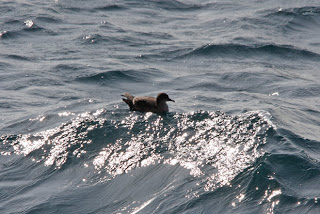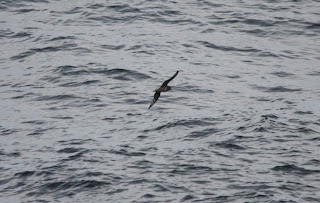I expect the southern tip of Wakayama could be good for sea-watching, particularly after a typhoon, but it's so far from my home I've never tested the theory. I have no doubt that at least Streaked Shearwater would be easy to see here. In fact huge numbers of Streaked come through the narrow neck into the large enclosed waters of Ise Bay. Thus it can often be seen from the shore at "inland sites" such as Tsu and Matsusaka cities that I often visit looking for passage waders. One of my biggest surprises birding in Kyoto city was watching a Streaked Shearwater circling the fields at Ogura before settling on the Uji River!
Nevertheless Kyoto is only 35 minutes by shinkansen from Nagoya, departure point for the Taiheiyo ferry (http://www.taiheiyo-ferry.co.jp/english/) to Tomakomai (Hokkaido) giving easy access to some potentially great seabirding. Thus for me this ferry route feels like an extension of Kansai. The ferry departs in the evening 3-4 times a week and arrives in Hokkaido 40 hours later after a brief stop in Sendai. Unfortunately the excellent waters off northern Honshu are missed during hours of darkness in both directions, but it offers the best possible seabirding from a Kansai base. I've done this run many times and in all seasons, either en route to Hokkaido or purely for seabirding coming straight back on the return sailing.
When I first came to Japan Short-tailed Albatross was ridiculously difficult to see from the Hokkaido ferry but now that numbers are increasing it's seen far more often. They are most commonly seen off Chiba to the south of the popular Oarai-Tomakomai route making the Nagoya-Tomakomai best of the northern ferry routes for this species. Short-tailed sometimes soar quite high above the sea, I've never seen Laysan or Black-footed (or any other albatrosses) do this, and this behaviour can draw attention to very distant birds. Though more numerous now, they are still usually the least common albatross on this route and as a winter breeder they're unlikely to be seen in summer. The very elegant and long-winged Black-footed is normally more frequent but not usually common enough to challenge Laysan in the numbers game. Congregations of hundreds of albatrosses can sometimes be seen swarming around fishing boats.
Wandering Albatross is included in most publications though according to the OSJ list it is currently unacceptable.
Black-footed Albatross, September. They look longer-winged and more elegant than the chunky Laysan.
Two typical Laysan, September.
The underwing of Laysan is quite variable and this December bird is well towards the light end of the scale with only limited black in the coverts. The very pale upperwing is presumably due to wear.
As mentioned, Streaked is the common year-round shearwater. The common migrants are Sooty and Short-tailed which can be seen in vast numbers while their migration is taking them through Japanese waters, and probably in smaller numbers year round. Flesh-footed are occasional and Buller's very uncommon to rare, I've only seen the latter close to Hokkaido. Further south towards Ogasawara Wedge-tailed replaces Streaked as the common shearwater. Bannerman's is less common, a summer breeder, in the Ogasawara and Iwo groups and probably far more numerous in the Iwo Islands. Bryan's is a winter breeder presumably occupying the same breeding sites but as there's no way of reaching the Iwo Islands at that time of year (unless you have your own boat) their status remains a mystery.
Manx, Newell's, Christmas Island and Tropical have also occurred in Japanese waters.
Wedge-tailed replaces Streaked in more southern waters and is common on the Ogasawara ferry route.
Sooty Shearwater, May.
 I confess this shot was taken in New Zealand, it would be nice to see them as well as this in Japan but the huge ferries aren't the best platforms to get great photographs from.
I confess this shot was taken in New Zealand, it would be nice to see them as well as this in Japan but the huge ferries aren't the best platforms to get great photographs from. There are a variety of petrels that could turn up on the northern route depending on the time of year and the prevailing weather conditions but nothing can be safely predicted. Even "certainties" can be totally absent. Immediately after a typhoon in 2009 I saw Providence Petrel (4), White-necked Petrel (17), Stejneger's Petrel (1-3), pterodroma sp? (27+) and Buller's Shearwater (1) on an outward journey but nothing at all on the return leg! One July many years back I had Wilson's, Matsudaira's and Bulwer's on the same trip and have never seen any of them on this route since. Kermadec is another pterodroma I've seen from this ferry, so it really is productive from the perspective of a Japan resident.
Where the northern route really comes into its own is for Oceanodroma petrels; Leaches, Band-rumped and Swinhoe's are summer breeders off northern Honshu (the Oarai ferry is probably better for these) and Tristram's is a more southerly winter breeder which I sometimes see at dawn on the north bound leg or at dusk on the last day of the return trip as the ferry passes closest to their Izu breeding islands, southern ferry routes are better for this species. Matsudaira's breeds further south and is only likely to be seen from the Ogasawara ferry. Fork-tailed on the other hand only just makes it into northernmost Japanese waters, mainly in winter. It continues to be a gaping hole on my Japan seabird list.
One of four Providence Petrels early one morning as the ferry entered Hokkaido waters, September 2009.
























No comments:
Post a Comment